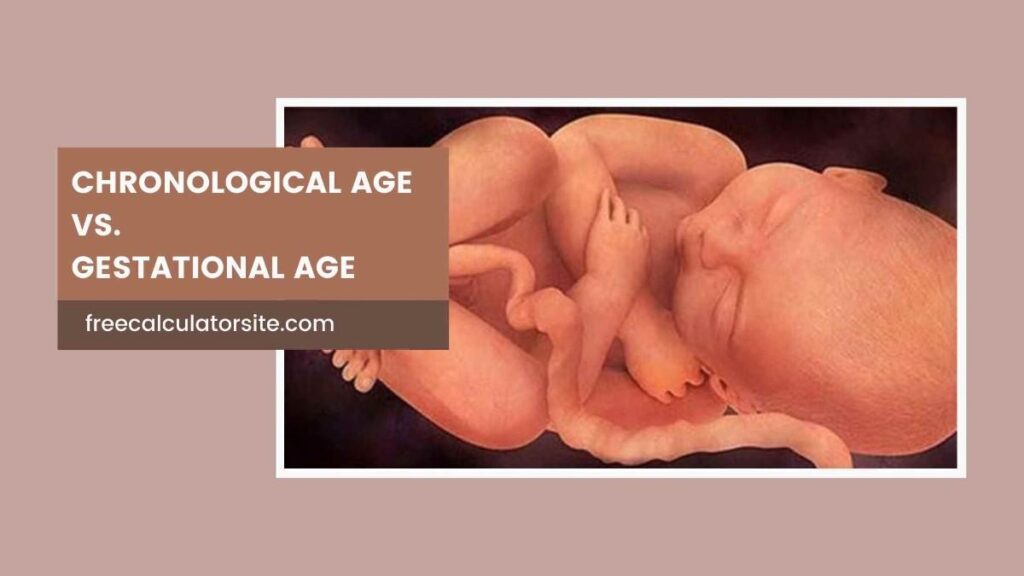Last updated on September 21st, 2024 at 07:26 pm

When it comes to understanding human development, two key terms often come up: chronological age and gestational age.
While both are used to measure time, they represent different phases and contexts of development.
Chronological age refers to the amount of time that has passed since a person was born, whereas gestational age refers to the time a fetus has been developing in the womb, starting from conception.
Both of these measures are crucial in different contexts, particularly in medicine, child development, and healthcare.
This article delves into the distinctions between chronological and gestational age, their relevance in different settings, and how they are used to assess health and development at various life stages.
What is Chronological Age?
Chronological age is the simplest and most commonly used way to measure a person’s age. It refers to the number of years, months, and days that have passed since a person was born.
Chronological age is typically expressed in years, with increments based on birthdays.
For example, if someone was born in 2000, their chronological age in 2024 would be 24 years.
Importance of Chronological Age
Chronological age plays a vital role in many aspects of life.
It is used to determine legal rights and responsibilities, eligibility for schooling, work, and social services, as well as assessing developmental milestones in children and adolescents.
For instance:
- Legal Significance: Chronological age is crucial when it comes to voting rights, the age of consent, or the legal drinking age. These rights are tied directly to how many years someone has lived.
- Educational Systems: School admissions, grade level, and educational assessments are often based on chronological age. Students are typically grouped by their birth year to standardize learning objectives.
- Healthcare Assessments: Medical professionals use chronological age to monitor growth and development, especially in children. Growth charts and developmental milestones are often measured based on how old a child is in months or years.
What is Gestational Age?
Gestational age, on the other hand, is a measure of how long a fetus has been developing in the womb.
It is calculated from the first day of the mother’s last menstrual period (LMP) to the current date.
This is a standard practice in obstetrics and gynecology because the exact date of conception is often difficult to determine.
Gestational age is typically measured in weeks, with a full-term pregnancy lasting about 40 weeks.
However, babies born anywhere between 37 and 42 weeks are still considered full-term.
Any baby born before 37 weeks is considered premature, while those born after 42 weeks are considered post-term.
Importance of Gestational Age
Gestational age is especially important in monitoring pregnancy and assessing fetal development.
It helps doctors and parents anticipate developmental stages and potential complications that could arise during pregnancy or birth.
Some key aspects include:
- Determining Prematurity: One of the most critical uses of gestational age is determining whether a baby is premature. Babies born prematurely may face a range of health challenges, including underdeveloped lungs, low birth weight, and difficulty regulating body temperature.
- Tracking Fetal Growth: Gestational age helps obstetricians assess whether the fetus is growing at a normal rate. Fetal measurements like head circumference, abdominal circumference, and femur length are compared to gestational age standards to identify any potential developmental issues.
- Planning Interventions: For high-risk pregnancies or when complications arise, knowing the gestational age allows doctors to plan medical interventions. For instance, if labor starts prematurely, gestational age will guide decisions regarding steroid injections to accelerate lung development in the baby.
Key Differences Between Chronological Age and Gestational Age
While both chronological and gestational ages are used to measure time, the differences between them are significant.
Here are some key distinctions:
Starting Point:
- Chronological Age: Begins at birth and counts forward in time.
- Gestational Age: Begins from the mother’s last menstrual period (usually two weeks before actual conception) and continues until birth.
Measurement Units:
- Chronological Age: Expressed in years, months, and days.
- Gestational Age: Measured in weeks and sometimes days.
Use and Application:
- Chronological Age: Used throughout life to assess legal rights, developmental milestones, educational placement, and medical care.
- Gestational Age: Primarily used in prenatal and neonatal healthcare to monitor the development of the fetus and plan for childbirth.
Developmental Context:
- Chronological Age: Applies after birth and covers all stages of life, from infancy through adulthood.
- Gestational Age: Only applies to the period from conception to birth, and its relevance ends once the baby is born and begins life outside the womb.
Also Read: What is Biological Age?
Why the Distinction Matters
Understanding the difference between chronological and gestational age is essential, especially in healthcare, because these measures can significantly affect how development is assessed and treated.
For instance, in the case of premature infants, chronological age may not be the best indicator of their developmental stage.
A baby born at 30 weeks gestation, for example, may be several weeks behind in terms of developmental milestones compared to a full-term baby of the same chronological age.
In such cases, doctors often use a corrected age or adjusted age, which factors in the baby’s gestational age at birth to more accurately track developmental progress.
This distinction also matters in understanding developmental expectations.
Children born prematurely may take longer to reach milestones like sitting up, crawling, and walking, and this is normal when their gestational age is considered.
Pediatricians will often adjust for this when evaluating developmental progress during the first few years of life.
Practical Applications in Medicine
- Neonatal Care: In neonatal intensive care units (NICUs), the gestational age of a newborn is a critical factor in determining the level of care they require. A 32-week premature infant will have different needs than a 36-week infant, even though their chronological ages may be just days or weeks apart.
- Pediatric Growth Tracking: Pediatricians may use both chronological and gestational ages to track a child’s growth and development, particularly in the case of premature babies. As mentioned earlier, corrected age (chronological age minus the number of weeks of prematurity) is often used for a more accurate understanding of developmental progress.
- High-Risk Pregnancies: Gestational age helps in planning deliveries, especially in high-risk pregnancies. Knowing the exact gestational age ensures that delivery is timed to maximize the health of both mother and baby.
Conclusion
Both chronological age and gestational age are critical in understanding and assessing human development, but they apply to different stages of life.
Chronological age helps us understand a person’s development post-birth, while gestational age is essential for tracking fetal growth and development during pregnancy.
Knowing the differences between these two measures is not only important for healthcare professionals but also for parents, educators, and anyone involved in child development.
By considering both chronological and gestational age, we gain a more nuanced and comprehensive understanding of growth, development, and the unique needs of individuals at various stages of life.

Akash Singh is a finance enthusiast who shares valuable insights on various calculators.
